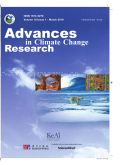- 钛学术文献服务平台 \
- 学术期刊 \
- 基础科学期刊 \
- 天文学、地球科学期刊 \
- 气候变化研究进展(英文版)期刊 \
A shallow ice core from East Greenland showing a reduction in black carbon during 1990-2016
A shallow ice core from East Greenland showing a reduction in black carbon during 1990-2016
基本信息来源于合作网站,原文需代理用户跳转至来源网站获取
摘要:
This study reports on the measurements of ion and refractory black carbon(rBC)concentrations in a shallow(10.96 m)ice core sample which was drilled from the field site of the East Greenland Ice Core Project(EGRIP)in July,2016.The results provide a recent record of rBC deposition in the East Greenland ice sheet from 1990 to 2016.The annual variability in oxygen(δ18O)and hydrogen(δD)isotopic compositions indicated that notably warm events occurred since 2008.Peaks in rBC occurred during summer seasons,which may be attributed to the burning of biomass in boreal summer.The rBC record and analysis of historical air trajectories using the HYSPLIT model indicated that anthropogenic BC emissions from Russia,North America and Europe contributed to the majority of rBC deposition in the Greenland region,and a reduction in anthropogenic BC consumption in these areas played a dominant role in the decrease in BC concentrations since 2000.This record also suggests that the emissions from the East Asian region(China)contributed very little to the recorded BC concentrations in East Greenland ice core.The model results indicated that radiative forcing due to BC had decreased significantly since 1990,and had remained below 0.02 W m-2 since 2000.

推荐文章
Sources of dissolved inorganic carbon in rivers from the Changbaishan area, an active volcanic zone
Carbon isotopes
Dissolved inorganic carbon
Rivers
Chemical weathering
Changbaishan
Active volcanic zone
Iron isotope fractionation during fenitization: a case study of carbonatite dykes from Bayan Obo, In
Iron isotopes
Fenitization
Fluid exsolution
Carbonatite
Bayan Obo
Carbon dioxide emissions from the Three Gorges Reservoir, China
CO2 emissions
Three Gorges Reservoir
River-type reservoir
Identification of terrigenous and autochthonous organic carbon in sediment cores from cascade reserv
Cascade reservoirs
Terrigenous OC
Lignin
Autochthonous OC
Three-end-member mixing model
内容分析
关键词云
关键词热度
相关文献总数
(/次)
(/年)
文献信息
| 篇名 | A shallow ice core from East Greenland showing a reduction in black carbon during 1990-2016 | ||
| 来源期刊 | 气候变化研究进展(英文版) | 学科 | |
| 关键词 | |||
| 年,卷(期) | 2020,(4) | 所属期刊栏目 | Changes in climate system |
| 研究方向 | 页码范围 | 360-369 | |
| 页数 | 10页 | 分类号 | |
| 字数 | 语种 | 英文 | |
| DOI | |||
五维指标
引文网络
引文网络
二级参考文献 (0)
共引文献 (0)
参考文献 (43)
节点文献
引证文献 (0)
同被引文献 (0)
二级引证文献 (0)
1998(1)
- 参考文献(1)
- 二级参考文献(0)
2003(1)
- 参考文献(1)
- 二级参考文献(0)
2005(1)
- 参考文献(1)
- 二级参考文献(0)
2006(2)
- 参考文献(2)
- 二级参考文献(0)
2007(5)
- 参考文献(5)
- 二级参考文献(0)
2009(6)
- 参考文献(6)
- 二级参考文献(0)
2010(3)
- 参考文献(3)
- 二级参考文献(0)
2011(1)
- 参考文献(1)
- 二级参考文献(0)
2012(2)
- 参考文献(2)
- 二级参考文献(0)
2013(4)
- 参考文献(4)
- 二级参考文献(0)
2014(4)
- 参考文献(4)
- 二级参考文献(0)
2015(4)
- 参考文献(4)
- 二级参考文献(0)
2017(1)
- 参考文献(1)
- 二级参考文献(0)
2018(7)
- 参考文献(7)
- 二级参考文献(0)
2019(1)
- 参考文献(1)
- 二级参考文献(0)
2020(0)
- 参考文献(0)
- 二级参考文献(0)
- 引证文献(0)
- 二级引证文献(0)
引文网络交叉学科
相关学者/机构
期刊影响力
气候变化研究进展(英文版)
主办单位:
国家气候中心
出版周期:
季刊
ISSN:
1674-9278
CN:
11-5918/ P
开本:
16开
出版地:
北京市中关村南大街46号国家气候中心
邮发代号:
创刊时间:
2010
语种:
eng
出版文献量(篇)
377
总下载数(次)
0
总被引数(次)
708
期刊文献
相关文献
推荐文献
- 期刊分类
- 期刊(年)
- 期刊(期)
- 期刊推荐
力学
化学
地球物理学
地质学
基础科学综合
大学学报
天文学
天文学、地球科学
数学
气象学
海洋学
物理学
生物学
生物科学
自然地理学和测绘学
自然科学总论
自然科学理论与方法
资源科学
非线性科学与系统科学
气候变化研究进展(英文版)2022
气候变化研究进展(英文版)2021
气候变化研究进展(英文版)2020
气候变化研究进展(英文版)2019
气候变化研究进展(英文版)2018
气候变化研究进展(英文版)2017
气候变化研究进展(英文版)2016
气候变化研究进展(英文版)2015
气候变化研究进展(英文版)2014
气候变化研究进展(英文版)2013
气候变化研究进展(英文版)2012
气候变化研究进展(英文版)2011
气候变化研究进展(英文版)2010

 免费查重
免费查重










